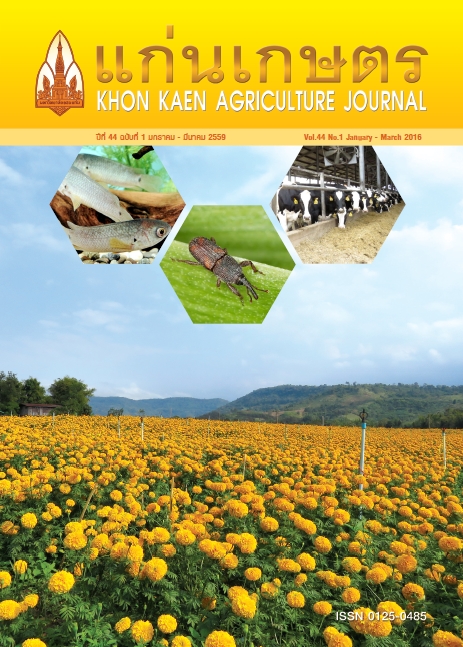แบคทีเรียที่มีบทบาทต่อการเปลี่ยนแปลงสารอนินทรีย์ในดินกรดกำมะถันชุดดินรังสิต
Main Article Content
บทคัดย่อ
การศึกษากลุ่มแบคทีเรียที่มีบทบาทในการเปลี่ยนแปลงสารอนินทรีย์ในดินกรดกำมะถันชุดดินรังสิตในสภาพรีดักชัน ด้วยเทคนิค denature gradient gel electrophoresis (DGGE) และวิเคราะห์ความสัมพันธ์ระหว่างกลุ่มแบคทีเรียกับสารอนินทรีย์ถูกเปลี่ยน ด้วยวิธี canonical correspondence analysis (CCA) ดำเนินการโดยวิเคราะห์สมบัติเบื้องต้นของดิน และนำดินมาบ่มจำลองสภาพขังน้ำในห้องปฏิบัติการ ผลการศึกษา พบว่า ดินรังสิตมีเนื้อเป็นดินเหนียวและมีพีเอชเป็นกรดรุนแรงมาก (pH 4.3) ผลการศึกษา พบว่า ปริมาณไนเทรตในสารละลายดินลดลงอย่างรวดเร็วตั้งแต่ศักย์ไฟฟ้ารีด็อกซ์ +200 มิลลิโวลต์ลงไป และหมดไปเมื่อศักย์ไฟฟ้ารีด็อกซ์เท่ากับ 0 มิลลิโวลต์ ปริมาณแมงกานีสที่ละลายน้ำได้ในดิน เริ่มสูงขึ้นตั้งแต่ศักย์ไฟฟ้ารีด็อกซ์ +200 มิลลิโวลต์ จนมีค่าสูงสุดเท่ากับ 14 มก./กก. ที่ -150 มิลลิโวลต์ เหล็กในสารละลายดินเพิ่มขึ้นชัดเจนตั้งแต่ศักย์ไฟฟ้ารีด็อกซ์ +150 มิลลิโวลต์ สำหรับปริมาณซัลเฟตมีแน้วโน้มเพิ่มขึ้นอย่างช้าๆ ตั้งแต่ช่วงต้น สามารถแบ่งตามความสัมพันธ์ระหว่างกลุ่มแบคทีเรียและการเปลี่ยนแปลงสารประกอบอนินทรีย์ในดินได้เป็น 4 กลุ่ม ดังนี้ 1) กลุ่มของแบคทีเรียที่มีความเด่นในช่วงที่ยังไม่มีการเปลี่ยนแปลงของสารอนินทรีย์อื่นๆ 2) กลุ่มที่สามารถอยู่ได้ทั้งที่มีออกซิเจน และเมื่อออกซิเจนหมดไป โดยสามารถรีดิวซ์ได้ทั้งไนเทรต เหล็ก และแมงกานีส 3) กลุ่มที่มีความเด่นในช่วงศักย์ไฟฟ้ารีด๊อกซ์ตั้งแต่ +150 ถึง -250 มิลลิโวลต์ ซึ่งเป็นช่วงที่มีการรีดักชันของไนเทรต เหล็ก แมงกานีส และซัลเฟต โดยเฉพาะอย่างยิ่งในช่วงที่มีการรีดักชันของเหล็ก แมงกานีส และซัลเฟต และ 4) กลุ่มที่มีพบในช่วงที่มีการรีดักชันเฉพาะของเหล็ก แมงกานีส และซัลเฟต
Article Details
เอกสารอ้างอิง
ทัศนีย์ อัตตะนันทน์. 2550. ดินที่ใช้ปลูกข้าว. ภาควิชาปฐพีวิทยา คณะเกษตร มหาวิทยาลัยเกษตรศาสตร์, กรุงเทพฯ.
ทัศนีย์ อัตตะนันทน์ และ จงรักษ์ จันทร์เจริญสุข. 2551. การวิเคราะห์ดินและพืช. ภาควิชาปฐพีวิทยา คณะเกษตร มหาวิทยาลัยเกษตรศาสตร์, กรุงเทพฯ.
Akob, D.M., H.J. Mills, T.M. Gihring, L. Kerkhof, and J.W. Stucki. 2008. Functional diversity and electron donor dependence of microbial populations capable of U (VI) reduction in radionuclide-contaminated subsurface sediments. Appl. Environ. Microbiol. 74: 3159-3170.
Attanandana, T. 2000. Paddy Soil Science. Department of Soil Science, Faculty of Agriculture, Kasetsart Univer-sity, Bangkok. Cited W.H. Patrick, B.G. Williams and J.T. Moraghan. 1973. A simple system for controlling redox potential and pH in soil suspension. Soil Sci. Soc. Amer. Proc. 37: 33-332.
Gao, S., K.K. Tanji, S.C. Scardaci, and A.T. Chow. 2002. Comparison of redox indicators in a paddy soil dur-ing rice - growing season. Soil Sci. Soc. Am. J. 66: 805-817.
Heyrman, J., B. Vanparys, N.A. Logan, A. Balcaen, M. Rodrı ́guez-Dı ́az, A. Felske, and P.D. Vos. 2004. Bacillus novalis sp. nov., Bacillus vireti sp. nov., Bacillus soli sp. nov., Bacillus bataviensis sp. nov. and Bacillusdrentensis sp. nov., from the Drentse a grasslands. Inter. J. Sys. Evol. Microbiol. 54: 47-57.
Lueders, T. and M. Freidrich. 2000. Archaeal population dynamics during sequential reduction processes in rice field soil. Appl. Environ. Microbiol. 66: 2732-2742.
Michiko, M. N., and Z. Peter. 1998. Anaerobic growth of a “strict aerobe” (Bacillus subtilis). Annu. Rev. Microbiol. 52: 165-90.
Muyzer, G., E.C. De Waal, and A.G. Uitterlinden. 1993. Profiling of complex microbial populations by denaturing gradient gel electrophoresis analysis of polymerase chain reactions-amplified genes coding for 16S rRNA. Appl. Environ. Microbiol. 59: 695-700.
Patrick, W.H., and A. Jugsujinda. 1992. Sequential reduction and oxidation of inorganic nitrogen, manganese and iron in flooded soil. Soil Sci. Soc. Am. J. 56: 1071-1073.
Patrick, W.H., and C.N. Reddy. 1978. Chemical changes in rice soils. pp. 361-379. In Soils and Rice. International Rice Research Institute, Manila.Peters, V., and R. Conrad. 1996. Sequential reduction processes and initiation of CH4 production upon flooding of toxic upland soils. Soil Biol. Biochem. 28: 371-382.
Shelobolina, E.S., K. O’Neill, K.T. Finneran, L.A. Hayes, and D.R. Lovley. 2003. Potential for in situ bioremedi-ation of a low-pH, high-nitrate uranium-contaminated groundwater. Soil Sediment Contam. 12: 865-884.
Schluter, A., I. Ruiz-Trillo, and A. Pujol. 2011. Phylogenomic evidence for a Myxococcal contribution to the mitochondrial fatty beta-oxidation. PLos ONE 6(7); e21989.Supaphol, S. 2005. Intrinsic Bioremediation and the Molecular Analysis of Microorganisms in Hydrocarbon Contaminated Thai Soil. Ph.D. Thesis. Kasetsart University, Bangkok.
Ter Braak, C.J.F., and P. Smilauer. 2002. CANOCO Reference Manual and CanoDraw for Windows User’s Guide: Software for Canonical Community Ordination (version 4.5). Microcomputer Power, NY.Yu, K. and W.H. Patrick. 2004. Redox window with minimum global warming potential contribution from rice soils. Soil Sci. Soc. Am. J. 68: 2086-2091.
Ward, N.L., J.F. Challacombe, P.H. Janssen, B. Henrissat, P.M. Coutinho, M. Wu, G. Xie, D.H. Haft, and et al. 2009. Three genomes from the phylum Acidobacteria provide insight into the lifestyles of these microorganisms in soils. Appl. Environ. Microbiol. 75(7): 2046-2056.
Zhou, J., M.A. Bruns, and M.T. James. 1996. DNA recovery from soils of diverse composition. Am. Soc. Microbiol. 62: 316-322.


